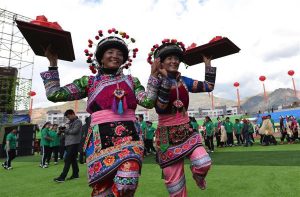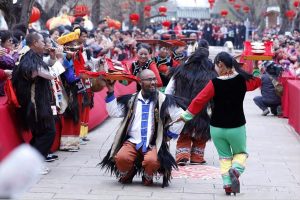 alt="Puer Surrounding Counties and Towns: Weekly & Special Local Markets Travel Guide"
/>
alt="Puer Surrounding Counties and Towns: Weekly & Special Local Markets Travel Guide"
/>
Tiaocai Dance of Yi Ethnic Minority in Nanjian County, Dali
The Tiaocai Dance of the Yi ethnic minority in Nanjian County, Yunnan Province, is a traditional dance that has a long history and is deeply rooted in the culture of the Yi people. It is a unique and fascinating dance that showcases the rich cultural heritage of the Yi people.
History of Tiaocai Dance
The Tiaocai Dance of the Yi people has a long history, dating back to the Ming and Qing dynasties. It originated from the Yi people’s celebration of the harvest and their gratitude for the blessings of the gods. The dance is traditionally performed during the “New Year’s Festival” of the Yi people, which is held in the twelfth month of the lunar year.
Features of Tiaocai Dance
The Tiaocai Dance is characterized by its unique choreography, lively music, and colorful costumes. The dancers wear traditional Yi costumes, with red and black as the main colors. The dance is performed to the beat of drums, gongs, and horns, and the dancers move in a lively and energetic manner, following the rhythm of the music.
The dance is divided into two parts, each with its own unique features. The first part is called “Wagging the Head,” where the dancers move their heads from side to side, simulating the movement of a chicken. The second part is called “Stamping the Feet,” where the dancers stamp their feet on the ground, creating a strong and vibrant rhythm.
Significance of Tiaocai Dance
The Tiaocai Dance of the Yi people is not only a form of entertainment but also a way for the Yi people to express their gratitude to the gods and to celebrate their harvest. The dance is also a way for the Yi people to showcase their rich cultural heritage and to preserve their traditional customs.
The Tiaocai Dance has become a symbol of the Yi people and is an important part of their cultural heritage. It is a dance that is deeply rooted in the culture of the Yi people and is a testament to their rich and diverse cultural traditions.
Visiting Nanjian County
If you are interested in visiting Nanjian County to see the Tiaocai Dance of the Yi people, you can plan your trip during the “New Year’s Festival” of the Yi people, which is usually held in the twelfth month of the lunar year. During this time, the streets of Nanjian County are filled with lively music and colorful costumes, and the Tiaocai Dance is performed throughout the county.
You can also visit the Nanjian Yi Autonomous County Museum, which showcases the rich cultural heritage of the Yi people. The museum has a collection of traditional Yi artifacts, including costumes, utensils, and musical instruments. Here, you can learn more about the history and culture of the Yi people and the significance of the Tiaocai Dance.
What is Tiaocai Dance

Tiaocai Dance” is also known as “lifting the dish dance” (called “Wu Cheba(吾切巴)” in the Yi language ). It is a one that dances to honor guests and increase the atmosphere of joy when serving in the banquet of the Yi Ethnic Minority in Nanjian (南涧县),Customary etiquette dance. people from the kitchen to the table are accompanied by music beats, dancing the unique dance steps of the Yi people, and humorously placing a dance, music and diet in a “chess” style.
Two Categories
“Dance between the tables”,also known as “mealing and dance” or “sudden dance”, is a major occasion for Nanjian people in wedding celebrations, bulid new houses, welcoming guests, and birthdays for the old peoples. Dish, “eat and be happy.”
“The stage dance” is the staged performance of the tiaocai, which are performed by the Nanjian peasants. The actors are usually around 20 people, and the number of actors is up to 100. The dance moves are bold and bold, strong and powerful, and the voice is high and bright. The “square-hopping dishes” actors are dozens of people, and many can reach hundreds of people, reflecting a magnificent, neat and harmonious artistic effect.

Reputation
In March 2003, the Ministry of Culture officially named Nanjian County as the “Hometown of Chinese Tiaocai Dance Art”. In 2008, “Nanjian Tiaocai Dance” was announced by the State Council as the second batch of national intangible cultural heritage protection projects. Since being moved to the stage by Nanjian native artists in April 1991, he has won numerous national, provincial and state music and dance awards.
Chinese Verrion: http://www.zgnj.gov.cn/dlnjwg/1154619150560133120/20101103/2506.html
http://www.sohu.com/a/206464268_660239

 7 Days GolfingTour
7 Days GolfingTour
 8 Days Group Tour
8 Days Group Tour
 8 Days Yunnan Tour
8 Days Yunnan Tour
 7 Days Shangri La Hiking
7 Days Shangri La Hiking
 11 Days Yunnan Tour
11 Days Yunnan Tour
 6 Days Yuanyang Terraces
6 Days Yuanyang Terraces
 11 Days Yunnan Tour
11 Days Yunnan Tour
 8 Days South Yunnan
8 Days South Yunnan
 7 Days Tea Tour
7 Days Tea Tour
 8 Days Muslim Tour
8 Days Muslim Tour
 12 Days Self-Driving
12 Days Self-Driving
 4 Days Haba Climbing
4 Days Haba Climbing
 Tiger Leaping Gorge
Tiger Leaping Gorge
 Stone Forest
Stone Forest
 Yunnan-Tibet
Yunnan-Tibet
 Hani Rice Terraces
Hani Rice Terraces
 Kunming
Kunming
 Lijiang
Lijiang
 Shangri-la
Shangri-la
 Dali
Dali
 XishuangBanna
XishuangBanna
 Honghe
Honghe
 Kunming
Kunming
 Lijiang
Lijiang
 Shangri-la
Shangri-la
 Yuanyang Rice Terraces
Yuanyang Rice Terraces
 Nujiang
Nujiang
 XishuangBanna
XishuangBanna
 Spring City Golf
Spring City Golf
 Snow Mountain Golf
Snow Mountain Golf
 Stone Mountain Golf
Stone Mountain Golf












 What Our Customers Say?
What Our Customers Say?
